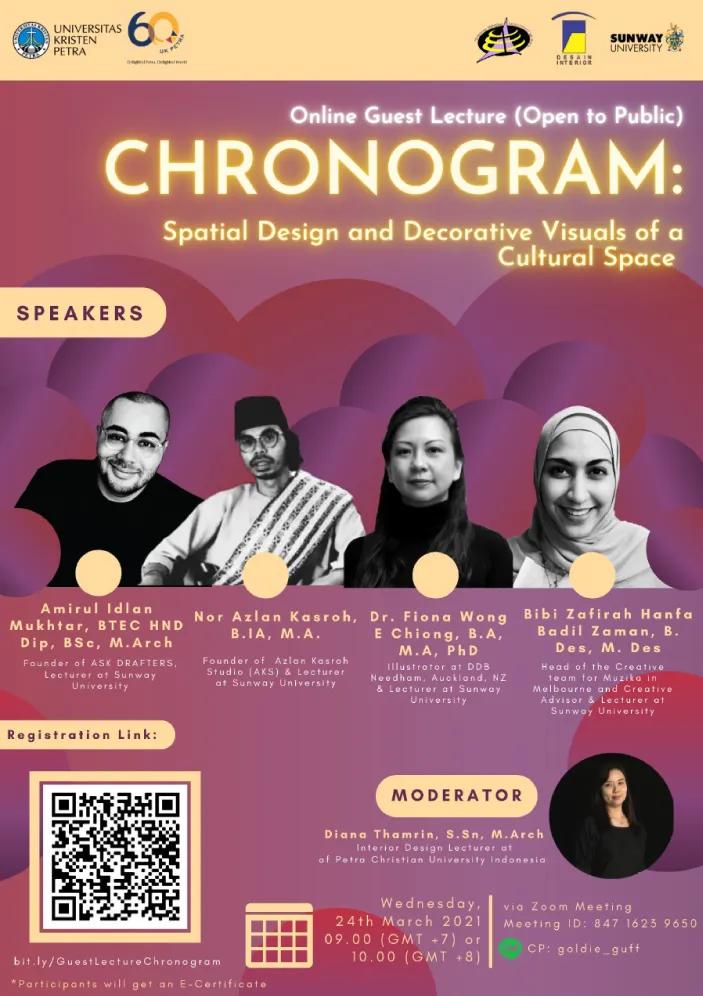Chronogram: Spatial Design and Decorative Visuals of a Cultural Space
Four lecturers from the Department of Art, Design and Media, School of Arts, Sunway University, were invited earlier this year by the Interior Design Department of Christian Petra University (Surabaya, Indonesia) to give an online guest lecture to their faculty and students. Moderated by Ms Diana Thamrin, the talk introduced Amirul Idlan Muktar, Dr Fiona Wong E Chiong, Nor Azlan Kasroh, and Bibi Zafirah Hanfa Badil Zaman titled “Chronogram: Spatial Design and Decorative Visuals of a Cultural Space”, looking at the designing and decorating of a cultural space. “Chronogram”, a word derived from Greek words chronos (‘time’) and gramma (‘letter’), refers to the inscription of texts that stand for a particular date and time, is a kind of indicative marker of a social and cultural context.
Culture is a set of beliefs and knowledge derived from a group of people or society and is a driving force of a vibrant society. Culture helps to guide future generations on how to create a better way of living. Design is a calculated process that requires multiple trials and errors, understanding the audience and is a complex yet subtle process. Put simply, design is everywhere, but only good design stands out to its audience.
Dr Fiona Wong explained the meaning and the association between visuals and culture. Cultures are different due to different ethnicities, traditions, beliefs, civilizations that began in different places, histories or even legends. People are constantly surrounded by different cultures, and this has a tremendous impact on the mind both consciously and subconsciously. Visual culture is a study of work that uses cultural influences into the results. It is an interlace of everything that one sees in daily life. Visual culture gives assurance to an individual, a sense of belonging and familiarity.
Amirul Idlan elaborated on how culture and space are classified into three categories: artifacts, nature and spirits. In order to achieve a certain goal, designers often use symbolic values in creating a space design.The demand for symbolic meaning applied into design creations has increased. The audience craves a way to evoke the feelings of pleasure and fantasies. By choosing proper socio-cultural signifiers, a space can stand on its own without any additional explanation; this is important to achieve the function and aesthetic appeal. Amirul explained different types of traditional houses globally, and how the Vernacular System has benefitted the people of a region. He continued on the traditional houses in Malaysia, focusing on ventilation, material, their poetic forms and functions. Memories play an important role when applying cultural experience into a space, as this will help the audience to remember their roots better. One way of doing this is by listening to the people, reinterpreting the information and retelling their stories through the space design.
Azlan Kasroh presented a case study revolving around the preservation of the Sultan Abu Bakar Museum, a heritage structure from the British colonial era. The chronographic projection of the building and visual approach captured the essence of its past. The museum was rebuilt in the concept of both hardscape and softscape in a poetic manner, synchronizing the meaning behind the function of the building that carried with it centuries of the Pahang royal family’s history. Numerous artifacts were displayed in the interior, showcasing the power and wealth of the Pahang royals and their culture. The building was transformed and upgraded where the structure carried tales of the past. The preservation also brought Pahang culture to the eyes of the world, certain artifacts like traditional textile and weaponry exhibited in an open concept aimed for educational purposes.
Bibi Zafirah Hanfa explained how cultural interpretations work and the possibilities to be incorporated in the styling of the interior. She iterated how colours and patterns have different meanings to different cultures and how this could be injected into the interior setting, but with a modern twist. There should always be a balance between the two. Hierarchy in a space could lead the viewer’s eyes to the focal point, and from one point to another. There are infinite possibilities in applying cultural influences into a space, but there is a fine line between over-doing it versus having just the right amount.
The talk received positive responses from the audience with many questions asked. The knowledge-sharing session highlighted the importance of cultural influences, how it is something that should not be neglected, celebrated and applied in modern spaces.
Bibi Zafirah Hanfa Badil Zaman
School of Arts
Email: @email




